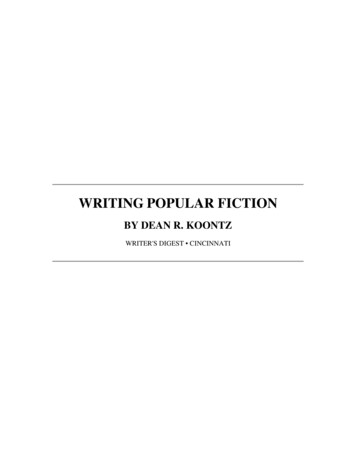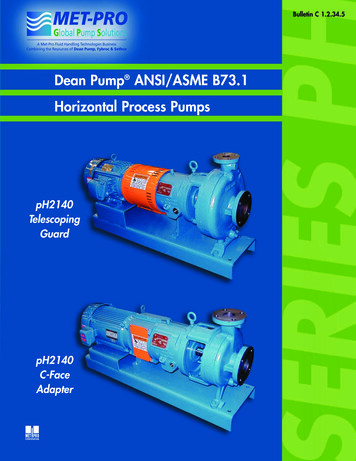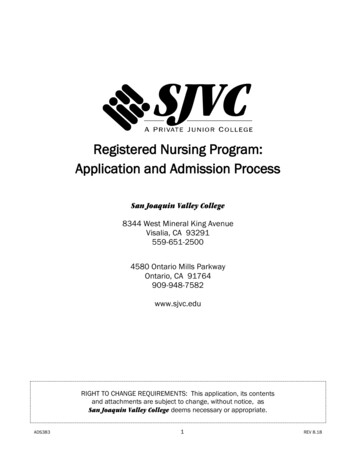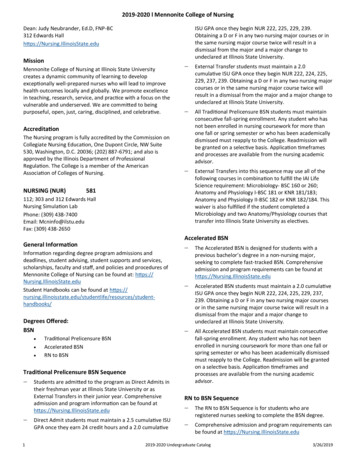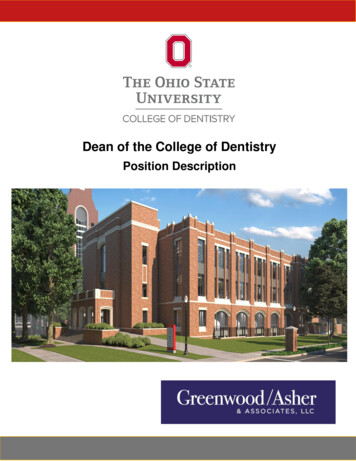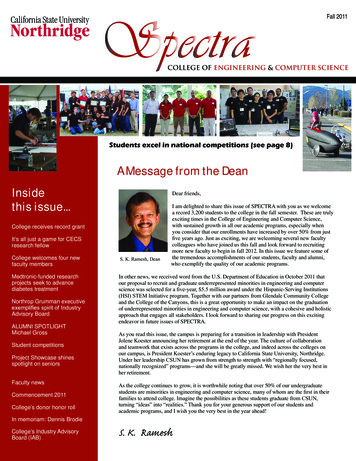
Transcription
Fall 2011COLLEGE OF ENGINEERING & COMPUTER SCIENCEStudents excel in national competitions (see page 8)A Message from the DeanInsidethis issue.Dear friends,College receives record grantIt’s all just a game for CECSresearch fellowI am delighted to share this issue of SPECTRA with you as we welcomea record 3,200 students to the college in the fall semester. These are trulyexciting times in the College of Engineering and Computer Science,with sustained growth in all our academic programs, especially whenyou consider that our enrollments have increased by over 50% from justfive years ago. Just as exciting, we are welcoming several new facultycolleagues who have joined us this fall and look forward to recruitingmore new faculty to begin in fall 2012. In this issue we feature some ofthe tremendous accomplishments of our students, faculty and alumni,who exemplify the quality of our academic programs.College welcomes four newfaculty membersS. K. Ramesh, DeanMedtronic-funded researchprojects seek to advancediabetes treatmentIn other news, we received word from the U.S. Department of Education in October 2011 thatour proposal to recruit and graduate underrepresented minorities in engineering and computerscience was selected for a five-year, 5.5 million award under the Hispanic-Serving Institutions(HSI) STEM Initiative program. Together with our partners from Glendale Community Collegeand the College of the Canyons, this is a great opportunity to make an impact on the graduationof underrepresented minorities in engineering and computer science, with a cohesive and holisticapproach that engages all stakeholders. I look forward to sharing our progress on this excitingendeavor in future issues of SPECTRA.Northrop Grumman executiveexemplifies spirit of IndustryAdvisory BoardALUMNI SPOTLIGHTMichael GrossStudent competitionsProject Showcase shinesspotlight on seniorsFaculty newsCommencement 2011College’s donor honor rollAs you read this issue, the campus is preparing for a transition in leadership with PresidentJolene Koester announcing her retirement at the end of the year. The culture of collaborationand teamwork that exists across the programs in the college, and indeed across the colleges onour campus, is President Koester’s enduring legacy to California State University, Northridge.Under her leadership CSUN has grown from strength to strength with “regionally focused,nationally recognized” programs—and she will be greatly missed. We wish her the very best inher retirement.As the college continues to grow, it is worthwhile noting that over 50% of our undergraduatestudents are minorities in engineering and computer science, many of whom are the first in theirfamilies to attend college. Imagine the possibilities as these students graduate from CSUN,turning “ideas” into “realities.” Thank you for your generous support of our students andacademic programs, and I wish you the very best in the year ahead!In memoriam: Dennis BrodieCollege’s Industry AdvisoryBoard (IAB)S. K. Ramesh
College receives record grantThe College of Engineering and Computer Science has beenawarded a five-year, 5.5 million HSI STEM grant by the U.S.Department of Education. The largest grant the college has everreceived, it will support efforts to increase the number of low-income,Hispanic and other underrepresented minority students who graduate withengineering and computer science majors.The project, developed in collaboration with two community collegepartners, College of the Canyons and Glendale Community College,has been designed to address the academic needs of Hispanic and lowincome students. Program components will include proactive academicadvisement and tracking, organized tutoring, peer and faculty mentoring,hands-on research opportunities and career advising to facilitate students’eventual transition to the workforce or advanced studies. Some of thefunds will be used to underwrite classes at the community colleges toensure students access to the prerequisites they need to transfer to CSUNin engineering and computer science. Participating students will receivestipends to motivate them and inspire them to succeed.In addition, the grant will expedite the development of sustainable,seamless transfer agreements between the community colleges andCSUN. Working collaboratively, faculty from the three institutionswill develop and team-teach courses and address gaps in the existingarticulation agreements.A unique aspect of the project is the integration of technology to enhancestudent learning. Through the grant, CSUN will create a mobile digitalenvironment with tablet PCs and software to enhance communication,engagement, collaboration and creativity and provide instant learningassessment for the students in the cohort.Altogether, the project is expected to facilitate the graduation of 120Hispanic and low-income students during the grant period.“It’s terrific to engage faculty and students in this exciting project, andwe’re confident that this program will make a difference in the lives andcareers of our students,” says CECS dean S. K. Ramesh.vIt’s all just a game for CECS research fellowCRichard LorentzProfessorComputer Scienceomputer science professor RichardLorentz takes his games seriously. Butyou won’t find him glued to a PlayStationor engrossed in the latest version of The Sims.In Lorentz’s world, games are an outstandingvehicle for testing computer algorithms, and asthe college’s 2011-12 research fellow, he’ll bespending the spring semester studying the meritsof different algorithms in computerized versionsof three lesser-known board games: Amazons,Havannah and EinStein würfelt nicht.many random games, and the move that does best across the random gamesis the one the player—in this case a computer—is “happiest” with.The difference between the two algorithms is striking. Before the discoveryof MCTS about six years ago, someone who had been playing Go for fouror five months could beat the best computer games. Using MCTS, however,a computer can play Go at the level of the top club players. “MCTS hasrevolutionized a lot of games,” Lorentz says.The catch is that no one knows why it performs so well. “Monte Carlo treesearch does better than we think it should,” he explains.“This is an ongoingproject I’ve been working on for years andwill continue for years,” he says.Photo by Ingo AlthöferHis project focuses on algorithms calledminimax and Monte Carlo tree search(MCTS). In the past, most computer boardgames relied on minimax, which arrives atthe best move by considering the player’spossible options, the opponent’s possibleresponses, the player’s responses to theseresponses, and so on, eventually accessingthe potential advantage each move willprovide the player. While it worked well ingames like chess, for complex games likethe classic Japanese game Go, it created ahopeless bottleneck. MCTS, by contrast, playsLorentz has been studying variations ofthe MCTS algorithm for some time, andhis Amazons program, a blend of minimaxand MCTS, is the current world champion.For his research project, he will expandhis investigation to additional games, incollaboration with students, who will learnthe algorithms, how to implement themefficiently and modify them for the task athand—skills they can adapt to the workplacewhenever they need to implement analgorithm they are unfamiliar with.2Lorentz (left) discusses abstract game theory with a colleague inJena, Germany.Fall 2011Lorentz’s own aim, while less pragmatic,could eventually prove transformative. “Myultimate goal is solving the mystery of whyMCTS is working so well,” he says. v
College welcomes four new faculty membersFor one it’s been a homecoming. For another it’s meant immersion in a completely new environment. For the othersit’s been like moving into new digs across town.CECS’s new faculty members have brought diverse backgrounds and areas of expertise to their new jobs, but all agree onone thing: joining the CSUN engineering and computer science faculty has been an excellent career move and promises to bepersonally and professionally rewarding.Alireza KabirianGeorge YoussefAbhijit MukherjeeAni NahapetianAssistant ProfessorManufacturing SystemsEngineering & ManagementAssistant ProfessorMechanical EngineeringAssistant ProfessorMechanical EngineeringAssistant ProfessorComputer ScienceAlireza Kabirian, an assistantprofessor in the Departmentof Manufacturing SystemsEngineering and Management andexpert in operations research andapplied statistics, has experiencedmore than his share of cultureshock in his career. After earninghis undergraduate and master’sdegrees in industrial engineeringin Iran, he came to the U.S. topursue a doctorate at Iowa StateUniversity. Following his Ph.D., hetaught at the University of Alaskain Anchorage for two years beforeabandoning the frigid north forSouthern California—a move thatpleased his new wife, who wasnot inclined to endure the harsharctic winters of the 49th state.While he admits that the region’scultural diversity and recreationalopportunities played a part inattracting him to the area, sincearriving at CSUN, Kabirian hasbeen especially impressed with howhelpful and friendly his colleagueshave been. “Everybody here tries tohelp me as a new faculty member,even if I don’t ask for help,” hesays. He also appreciates workingat a teaching university. “CSUNis doing a good job educatingour engineers for industry,” heobserves. “Here students willbe more prepared for real-worldproblem solving. This is what weteach them.”By contrast, George Youssef,an assistant professor in theDepartment of MechanicalEngineering, never really left thecollege. He arrived at CSUN asan undergraduate in 2003, earninghis bachelor’s degree in 2005.While working at his first job inaerospace, he began to pursue amaster’s degree and concurrentlystarted teaching part time atCSUN—something he continuedwhen he went on to UCLA for hisPh.D. While he enjoyed workingin industry, he was eager to focuson academia because he has apassion for teaching and, he notes,“In teaching you have opportunityto switch focus so many timesin your career, you never stoplearning.” As it happened, therewas a job opening at CSUN whenhe completed his doctorate. He washired, and now, he says, he feels asif he’s back home. He especiallyenjoys interacting with students—something they have not failed tonotice. Once, a student bet somefriends 20 that Youssef would stillbe in his office at 11 p.m.—a betthat he won. “The students kind ofpush you as a professor to performbetter, through the questions theyask,” he says.” I really enjoy thata lot.”Abhijit Mukherjee, who earnedhis bachelor’s degree in India andhis master’s at Villanova Universityin Pennsylvania, is no stranger toLos Angeles but, he admits, duringthe five years he spent workingon his Ph.D. at UCLA, he rarelycrossed into the San FernandoValley. So when he arrived atCSUN to interview for a job as anassistant professor of mechanicalengineering, he was pleasantlysurprised by the size and beautyof the campus. Now, as a memberof the faculty, he particularlyappreciates the student diversity,which he finds striking, and thequality of the campus facilities.“They’re the best you can findanywhere,” he says. An expert inheat transfer, fuel cell technologyand microfluidics, Mukherjee wasdrawn to Southern California asmuch for its weather, art, cultureand sports as for the excellentjob opportunity in the College ofEngineering and Computer Science.“LA is a very cosmopolitan place,”he says. ““I want to be successfulin my career as a CSUN facultymember and at the same time enjoylife and give my kids the bestpossible experience. There is nobetter place than LA.”Fall 2011Ani Nahapetian, assistantprofessor of computer science,loves travel and photography andespecially enjoys combining thetwo, but when it comes to hercareer, she hasn’t ventured farfrom home. She grew up in the SanFernando Valley, then earned herbachelor’s, master’s and doctoraldegrees at UCLA. Followingher Ph.D., she taught for a yearat California State University,Dominguez Hills before returningto UCLA as an adjunct professorand simultaneously working in thewireless health industry. “It was agreat opportunity and a springboardfor coming to CSUN,” she explains.An expert in embedded systems,especially hardware-based systemsecurity and sensor systems withhealth applications, Nahapetian hadbeen keeping an eye on CECS forjob openings in computer science.“I knew that I loved to teach andCSUN was a great place to do that,”she says. “I also had very positiveimpressions of faculty membersI had met at local conferences.”Now, only a few months into herfaculty appointment, she hasn’tonce looked back. She has had verypositive experiences with studentsand appreciates the university’ssupportive environment. “From allthese interactions, I can tell this iswhere I want to spend the rest ofmy career,” she says.v3
Medtronic-funded research projects seek to advancediabetes treatmentThe unique synergy between CSUN and the medical device company Medtronic Diabetes, located on the northernmost edge of the campus,regularly finds expression in research collaborations, internships and scholarships. Most recently, it has been manifest in research grantsthat the company (also known as Medtronic MiniMed) awarded to five CECS faculty members to fund one-year projects relevant todiverse aspects of diabetes and the company’s signature insulin pumps. All projects are involving students as integral members of the research team.Testing polymers to coatimplantable sensors. Implantingsensors under the skin tomeasure blood glucoseon a continuing basishas the potential tosimplify insulin regulationin diabetic patients,especially when pairedwith an insulin pump. Butthe technology is currentlyless than ideal becausewhile the insulin pumpslast five to eight years, thesensors, exposed to body fluids, degrade andhave to be replaced every few months, which isexpensive, inconvenient and painful. BehzadBavarian, professor of manufacturing systemsengineering and management, has received agrant to characterize and test different polymersto determine their suitability as coatings toprotect the sensors and their compatibility withthe human body.Developing performance modelsof multi-device body areanetworks and body area to offbody networks. Someday, in the not-too-distant future,medical deviceswill use wirelesstechnology to “talk”to each other andmonitor such thingsas blood glucoselevels in diabeticpatients. Before thatscenario can becomecommonplace,From left, Professors Flynn,however, developersKatz, and Schwartzwill need tocharacterize a complex set of variables relatingto sensor placement on the body and howthe dynamics of movement, activity levels,stature, body contours and position affect datatransmission between devices on and off thebody. Electrical and computer engineeringprofessors Sharlene Katz, James Flynn andDavid Schwartz have received funding todevelop a model of transmission and absorptionpatterns for the radio waves that will transmitthe data wirelessly. “Placing wireless sensors onbodies is a brand-new field,” says Katz. “There’svery little information on it. Wherever you putsensors—on an ankle, for instance—parts of thebody may block signal transmission betweendevices. It’s a very complex problem.” The team4is aiming to develop a set of guidelines for sensor placement, and the model they create may eventually allowMedtronic’s engineers to design systems that can reliably monitor the blood glucose levels of children, forexample, and alert a school- or home-based system when there is a problem that needs attention.Integrating diabetes databases. As the amount of information proliferates,it becomes increasingly challenging to compile and mine relevant data. A team led bycomputer science professor George Wang is laying the groundwork for integratingmultiple diabetes-related databases in ways that can benefit clinicians and patients (aswell as Medtronic researchers). Under Wang’s direction, a student team made up ofgraduate student Justin Peckner and senior Ian Maxon, both in computer science, andKevork Sepetci, an undergraduate in computer engineering, will create a prototype for acomprehensive diabetes database that synthesizes information from internal and externalsources, providing “one-stop shopping” for anyone seeking data about diabetes.Developing a feedback system to alleviate pressure on patients’ soles. As diabetesprogresses, one of the more common—and unfortunate—effects that patients mayexperience is the development of ulcers on the bottoms of their feet. In time, nervesmay be choked off and die, leading to neuropathy; bones may become brittle, andpatients’ arches may fall. Because they lack feeling in their soles, patients may not beaware of the problems, and many no longer walk with normal heel-to-toe flexion; theentire bottom of the foot hits the ground at the same time instead. Aksone Neuvong,D.P.M., at Olive View–UCLA Medical Center has been seeking a feedback systemfor diabetic patients that uses mapping information from the bottoms of their feet todetermine pressure points and then stimulates nerves and leg muscles to change theirgait, taking pressure off the sore spots and restoring normal flexion. Ben Mallard, alecturer in electrical and computer engineering, is working with graduate students tocreate an interface between the commercial mapping unit and the nascent CSUN feedbacksystem using Bluetooth protocol. “The patients will have electrodes in their socks or stockings, with sensorsplaced directly on the skin or proximal to the stimulation point for muscle and passive stimulation,” explainsMallard. “As they walk, the system will automatically stimulate the muscles to change their gait and deflect thepressure.” If successful, the project may also be applicable to other conditions that cause disability.Factoring patient activity into insulin dosage. Up to now, themedical device industry has relied on a model for insulindosage that is predicated on a person’s dietary intake. If apatient monitors his or her current sugar level and anticipateshaving a large meal, for instance, based on that information,he or she will need to inject a certain amount of insulin. Whatis lacking in this model, however, is consideration of thepatient’s physical activity throughout the day. A highly athleticperson’s energy expenditure, for example, isn’t factored intothe calculations, even though that activity is fueled by sugarsin the body, and that person would consequently need lessinsulin. Mechanical engineering professor C.T. Lin’s projectis seeking to develop a mathematical model for measuringand incorporating patient activity into the equation for insulin dosage, based oninformation from sensors that patients could wear to determine how much energyhas been consumed. While the initial phase of the project is a feasibility study, if itis successful, it could eventually lead to smarter insulin pumps and more accurateinsulin dosing. Graduate students Ara Mekhtarian and Craig Euler are assisting Linwith the project. vStudent Craig Euler shows the sensor (above right) andhow it is attached to a human subject to monitor physicalactivity. (Photo by student Ara Mekhtarian)Fall 2011
Northrop Grumman executive exemplifiesspirit of Industry Advisory BoardAbout five years ago, C.T.Lin, professor of mechanicalengineering, was trying to geta new student project under way. To moveforward, his team needed an inertial guidancesystem, an expensive component used innavigation. Because the system was madeby Northrop Grumman, CECS dean S. K.Ramesh approached the college’s man onthe inside, Charles Volk, to see if he couldget it for Lin’s team at a discount. Volk,vice president and chief technologist for thecompany’s Navigation Systems Division,did better than that: he arranged for it to bedonated. And last summer, using the unit,CSUN’s team took first place in the nationalIntell
families to attend college. Imagine the possibilities as these students graduate from CSUN, turning “ideas” into “realities.” Thank you for your generous support of our students and academic programs, and I wish you the very best in the year ahead! S. K. Ramesh. College receives re

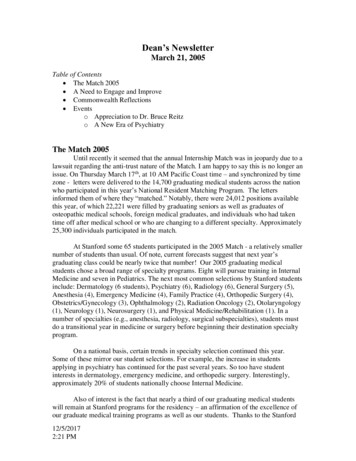
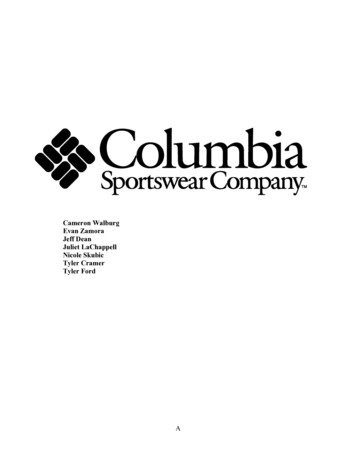


![Fear Nothing [039 5.0] By Dean R. Koontz](/img/5/fearnothing.jpg)
